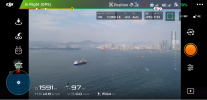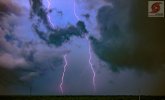- Joined
- Feb 8, 2018
- Messages
- 8,494
- Reactions
- 13,749
- Age
- 55
Since we fly mainly in Extreme Weather Conditions were in heavy winds more than most.
Here is a good way to determine very quickly if your drone can negotiate the winds .without an app.
If your drone can hold its Hover Position within 1 ft on either side of its position your in winds less than 10 Mph
2 ft of either side your in roughly 15 mph wind gusts.
3 ft your in 20 to 25 mph winds .
4 to 5 ft your in 30 mph winds of better. Although you can negotiate those winds , there can be risks of damage to the camera and the ribbon cable ..
Once you have judged the wind speed to be 15/20 mph or better keep your flights low if possible under 200 ft .
Here is an example of 20 mph winds as you watch the drone struggle to maintain 2 ft moving closer to 3ft away from its original Hover Position.
Video shows what happens when the drone meets 30 mph winds starts at 3:00 and threatens to tear the gimbal ribbon as the camera takes the full force of the winds at the open sea.
Those of us that have experience in flying in the wind can many times use the wind to our advantage such in this video where
Zeus is able to comeback from his test flight with only 39% battery, its an extraordinary level of understanding wind speed and knowing his drone. . ( note spotters were all around )
Winds are a Constant for every drone pilot and they need to be Negotiated on every flight
If you only fly on days when its 5 mph winds , your cheating yourself out of your hobby and some incredible drone flights.
Here is a good way to practice and prepare for what happens in the wind. Do this with each drone you own.
Choose a day with Consistent Winds and hover your Drone in Place so you can watch its every move.
Determine quickly how far is the Drone Moving from it hover Position . 1ft - 2ft - 3ft or more. 5ft and your passing the drones limits. Mark actual wind speed so you check yourself.
Notice the Tilt of the Drone and how it maintains that form but the gimbal holds the Horizon true.
Watch the Lights and look for the Green lights letting you know your good...
Slowly turn the drone into the wind and around in a circle slowly and watch how the camera responds or flips or turn or pushes up/down
These events can really throw a new pilot into a Panic so be aware that the Camera can mess up , the drone can tilt and drift away but the drone is fine.
The goal is to gain confidence in your drone and be able to fly more.
Snow is coming , and with it some incredible opportunity to have fun.
Judge the winds , and Get a Wet Suit to Protect your drone and the battery and Enjoy the Snow Covered world.
Phantomrain.org
Gear to fly your Mavic Air 2 in the Rain/Snow and Float on Water.
Here is a good way to determine very quickly if your drone can negotiate the winds .without an app.
If your drone can hold its Hover Position within 1 ft on either side of its position your in winds less than 10 Mph
2 ft of either side your in roughly 15 mph wind gusts.
3 ft your in 20 to 25 mph winds .
4 to 5 ft your in 30 mph winds of better. Although you can negotiate those winds , there can be risks of damage to the camera and the ribbon cable ..
Once you have judged the wind speed to be 15/20 mph or better keep your flights low if possible under 200 ft .
Here is an example of 20 mph winds as you watch the drone struggle to maintain 2 ft moving closer to 3ft away from its original Hover Position.
Video shows what happens when the drone meets 30 mph winds starts at 3:00 and threatens to tear the gimbal ribbon as the camera takes the full force of the winds at the open sea.
Those of us that have experience in flying in the wind can many times use the wind to our advantage such in this video where
Zeus is able to comeback from his test flight with only 39% battery, its an extraordinary level of understanding wind speed and knowing his drone. . ( note spotters were all around )
Winds are a Constant for every drone pilot and they need to be Negotiated on every flight
If you only fly on days when its 5 mph winds , your cheating yourself out of your hobby and some incredible drone flights.
Here is a good way to practice and prepare for what happens in the wind. Do this with each drone you own.
Choose a day with Consistent Winds and hover your Drone in Place so you can watch its every move.
Determine quickly how far is the Drone Moving from it hover Position . 1ft - 2ft - 3ft or more. 5ft and your passing the drones limits. Mark actual wind speed so you check yourself.
Notice the Tilt of the Drone and how it maintains that form but the gimbal holds the Horizon true.
Watch the Lights and look for the Green lights letting you know your good...
Slowly turn the drone into the wind and around in a circle slowly and watch how the camera responds or flips or turn or pushes up/down
These events can really throw a new pilot into a Panic so be aware that the Camera can mess up , the drone can tilt and drift away but the drone is fine.
The goal is to gain confidence in your drone and be able to fly more.
Snow is coming , and with it some incredible opportunity to have fun.
Judge the winds , and Get a Wet Suit to Protect your drone and the battery and Enjoy the Snow Covered world.
Phantomrain.org
Gear to fly your Mavic Air 2 in the Rain/Snow and Float on Water.
Last edited:













